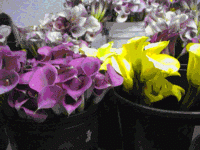Maturity and Quality
Callas should be harvested when the spathe has opened enough so that the spadix can be seen. Flowers harvested more mature will be more susceptible to damage, and may have reduced vase life. The flowers are normally pulled from the rhizome and re-cut to ensure adequate water uptake. The spadix (the thick fleshy inflorescence inside the showy spathe) should be visible at the time of purchase. Watch for bruising of the fleshy stems due to packaging. If cut too tight, flowers will usually not open properly.
Grading and Bunching. Quality callas have long stems, are uniform in maturity and color, and have no defects such as damage to the spathe or spadix. Both large and mini callas are normally bunched in 10’s. Mini callas are sometimes sleeved to provide additional protection.
Postharvest Handling and Storage
Callas should be stored at 0-1°C.
Calla flowers are not ethylene sensitive, although some researchers have shown the positive effects of STS pre-treatment. Contrary to popular belief, callas do not produce significant quantities of ethylene.
Packing
The flowers may be packed horizontally or in upright hampers or water packs. If packed horizontally avoid direct contact with cleats, which may damage the fleshy stems. Standard callas may bend in response to gravity unless held at the proper storage temperature.
Special Considerations
The mini-callas have fewer postharvest problems and are generally easier to handle and use because of their smaller size.
Disorders
Description
Zantedeschia spp. The striking white blooms of Zantedeschia aethiopica have long been an important cut flower, and new green-tinged and different-shaped variants are increasingly important. The hybrid ‘mini-callas’, with their elegant shape and wide range of colors, continue to increase in importance as cut flowers and potted plants. The showy ‘spathe’ is a leaf-like organ that surrounds the true flowers, the thick, fleshy ‘spadix’. The genus is named for Francesco Zantedeschia who wrote about Italian plants around 1825. Although often called calla lilies, these flowers are not related to the true lily.




